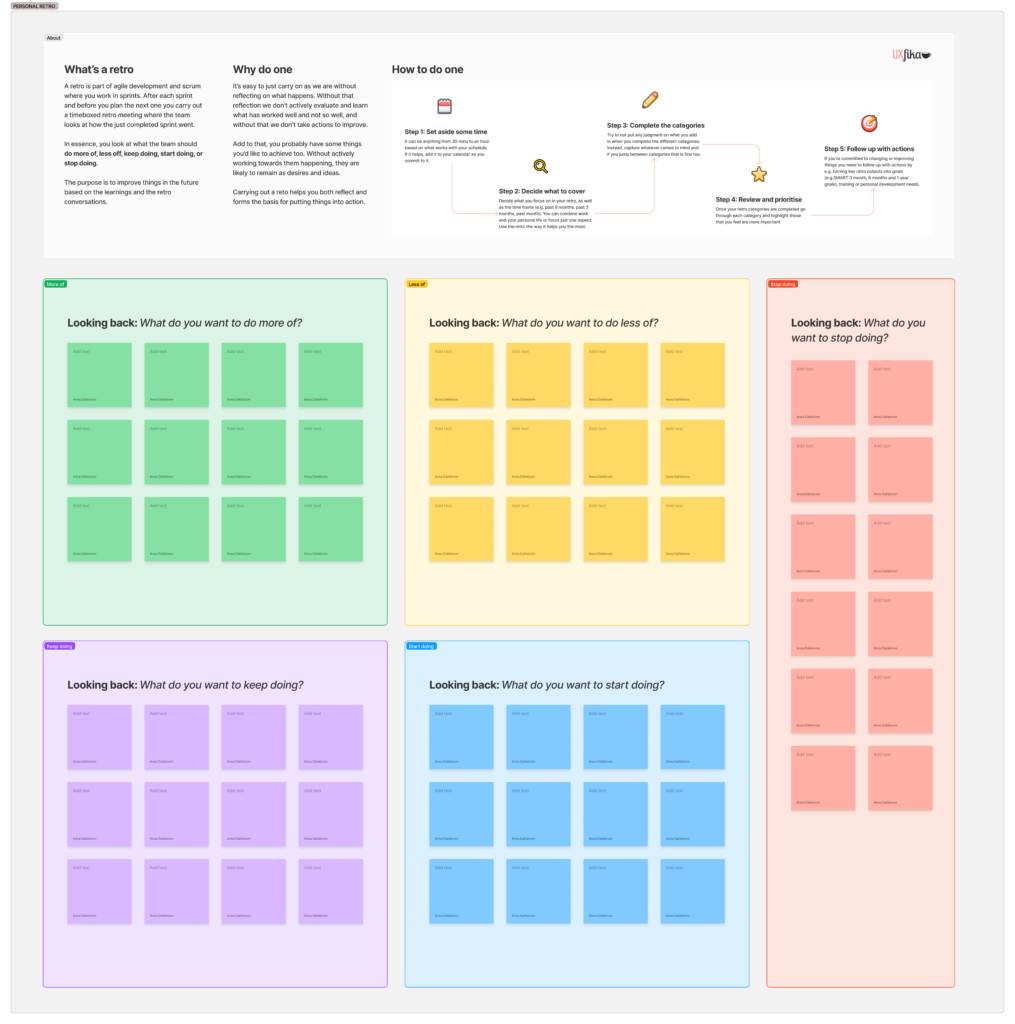Over the past month and a bit many of us have returned to work after the summer and the feelings might be mixed. Whether you’ve had a short or a longer break over the summer, now is a good time to do a retro of the first 9 months of this year, and to set your intentions and goals for the next 3.
‘Retro’ for those of you who aren’t familiar with the term, is part of agile development and scrum where you work in sprints. After each sprint and before you plan the next one you carry out a timeboxed retro meeting where the team looks at how the just completed sprint went. There are slight variations in what categories you cover and what you call them, as well as who should participate but in essence, you look at what went well, what went less well, what could be improved, and what should be avoided in the future. Or in other words what the team should do more of, less off, keep doing, start doing, or stop doing.
Why you should do your own retro
It’s easy to just carry on as we are without reflecting on what happens. The thing is, without that reflection we don’t actively evaluate and learn what has worked well and not so well and without that we don’t take actions to improve.
All relationships need to be nurtured and that goes for our relationship with work and how work integrates with our personal life too. Add to that, you probably also have some things you’d like to achieve. Without action and actively working towards them happening, they are likely to remain as desires and ideas in your head.
Though a retro can be done at any time and is favourably an exercise you should do on a regular basis, right now is a really good time. When we’re recently gone through a shift in our everyday pattern like going from holiday mode into work mode, reflections are more likely to pop up. Additionally, the “it is what it is” may be further away from your thoughts as you look at things a bit more critically.
Doing a retro will help you:
- Evaluate what matters to you at work and outside of work
- Identify what you want to do more and less of this autumn
- Identify what you want to keep on doing
- Identify what you want to stop doing/ experiencing
- Identify what you want to start doing/ experiencing
With all of that in mind let’s get to it.
How to carry out your retro
Below are a few pointers to help you get going as well as worksheet that you can work straight into:
1. Set aside some time
Start by setting aside some time for yourself this week when you do your retro. It can be anything from 30 mins to an hour based on what works with your schedule. If it helps, add it to your calendar so you commit to it.
2. Decide what to cover
Thinking back on the first 9 months of this year, decide what you want to cover and focus on in your retro. There might be specific aspects related to work that pop into mind, and/ or aspects related to how work impacts your personal life that you want more/ less of.
I’m personally in favor of focusing on work but also including aspects that matter to you in your personal life. What makes us happy outside of work will always have a positive impact on the work we do, and vice versa so it’s good to reflect on aspects relating to work-life balance in your retro too. However, if you want to keep the retro to just covering aspects related to your job that is absolutely fine.
3. Complete the different categories
As mentioned at the start of this post, there are various formats for retros (as you can see if you Goole agile retro). Use whichever categories that work best for you. I’ve created a blank retro template that you can work into. It’s in Figma but you can also easily just draw 5 boxes on a piece of paper/ create a document with 5 sections and add in the retro categories and your entries there. Alternatively, right-click the image below and open it in a new tab from where you can zoom in and download it.

Whichever format you chose, try to not put any judgment on what you add in when you complete the different categories. Instead, capture whatever comes to mind. The next step after completing the categories is to review and prioritise the output.
4. Review and prioritise the output
Once your retro categories are completed go through each category and highlight those entries in each category that you feel are more important. This can be done in different ways. If you have printed the retro worksheet you can circle or add a star to the points that you feel are most important. If you’ve done it digitally, then the tool you use might have elements you can add on (e.g. Figma Jam has voting stickers etc), or you can bold the typography on the ones that matters the most. If you want to go all out you can number the entries in each category from 1 being the most important and down to the least important card, e.g. from 1 to 7 if you have 7 entries in one retro category.
5. Follow up with actions
Having completed your retro is an important step but the reflection it gives you is just the first step. If you’re committed to changing or improving things you need to follow up with actions. All of those actions don’t need to be defined at the time when you do your retro, if you don’t have time, but can be done later. The important thing is that you follow up and actively work through the takeaways so that change happens. Personally, my next step has been to turn part of the prioritised retro output into goals for the next 3 months, and I’ve put dates in the calendar. Some points that come up in my retro I know I’m not in a position to action this year and so I’ve added them in as goals for Q1 and Q2 next year. And some bits are aspects I’m mindful of and working on a weekly and at times daily basis.
There is no set way of doing it but the action should be related back to the ‘what’ and the ‘why’ of retro output.
If you carry out your own retro, let me know if you found it useful


